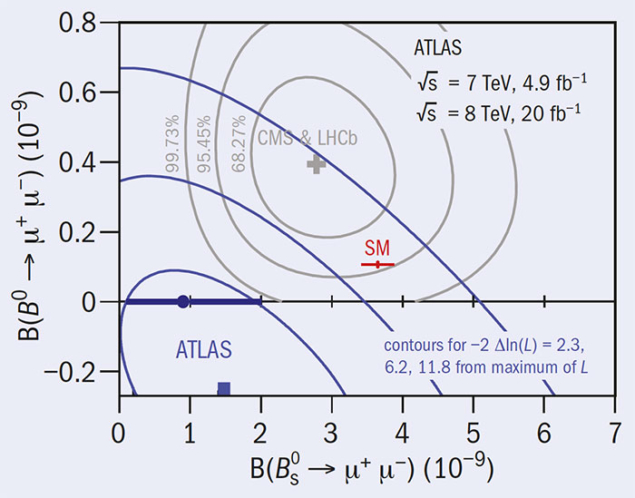
The decays of the B0s and B0 into muon pairs represent an important test of the Standard Model. Such decays take place through a flavour-changing neutral current process, which occurs only through loop diagrams and is further suppressed because the two muons are required to have equal helicity in order to conserve angular momentum.

Image credit: ATLAS Collaboration.
Although the very small value of the predicted branching fractions (3.7 × 10–9 and 1.1 × 10–10 for the B0s and B0, respectively) opens the possibility to search for new physics, the decays present a challenge for experimental programs. Physicists have been placing upper limits on these processes for more than 30 years, with the values decreasing by roughly two orders of magnitude every decade.
ATLAS recently presented the result of a study based on data collected during LHC Run 1, completing the results obtained by CMS and LHCb (CERN Courier September 2013 p19). The new analysis exploits multivariate techniques for the reduction of background events that could mask the small signal from B-meson decays. A first classifier is used to reduce the background due to muons from uncorrelated decays of B hadrons, while a second classifier is used to reduce the fraction of hadrons wrongly identified as muons. Misidentification contributes to the background due to partially reconstructed decays, and is at the origin of the resonant background due to B0s decays into pairs of charged mesons when both are mistaken as muons. ATLAS has achieved values of about 0.10% and 0.05% for the probability of a kaon or a pion to be wrongly identified as a muon, pushing the resonant background below the predicted level of the signal.
For the B0s meson, the branching fraction measured by ATLAS is B(B0s → μ+μ–) = (0.9+1.1–0.8) × 10–9, with an upper limit of 3.0 × 10–9 at a 95% confidence level. The result agrees, within uncertainties, with those of CMS and LHCb. It is lower than the Standard Model prediction but is compatible at the level of two standard deviations. For the B0 an upper limit B(B0 → μ+μ–) < 4.2 × 10–10
is set at a confidence level of 95%, which again is compatible with previous evidence and predictions.
The new result constrains models for new physics that predict a significant enhancement of these B decays, such as some with an extended Higgs sector. Deviations in the direction of lower branching fractions require further clarification with data collected during LHC Run2.








